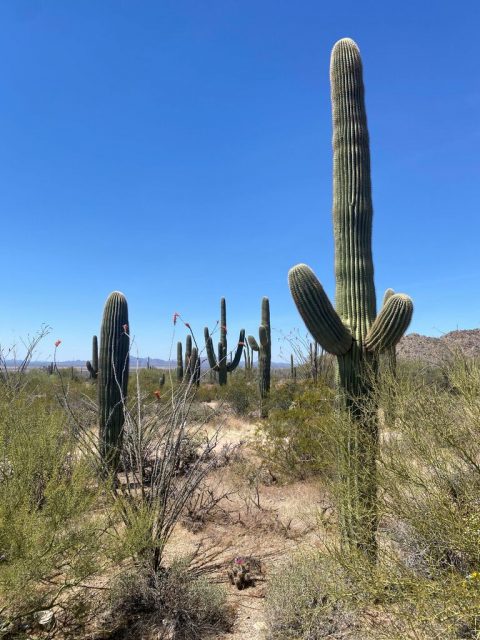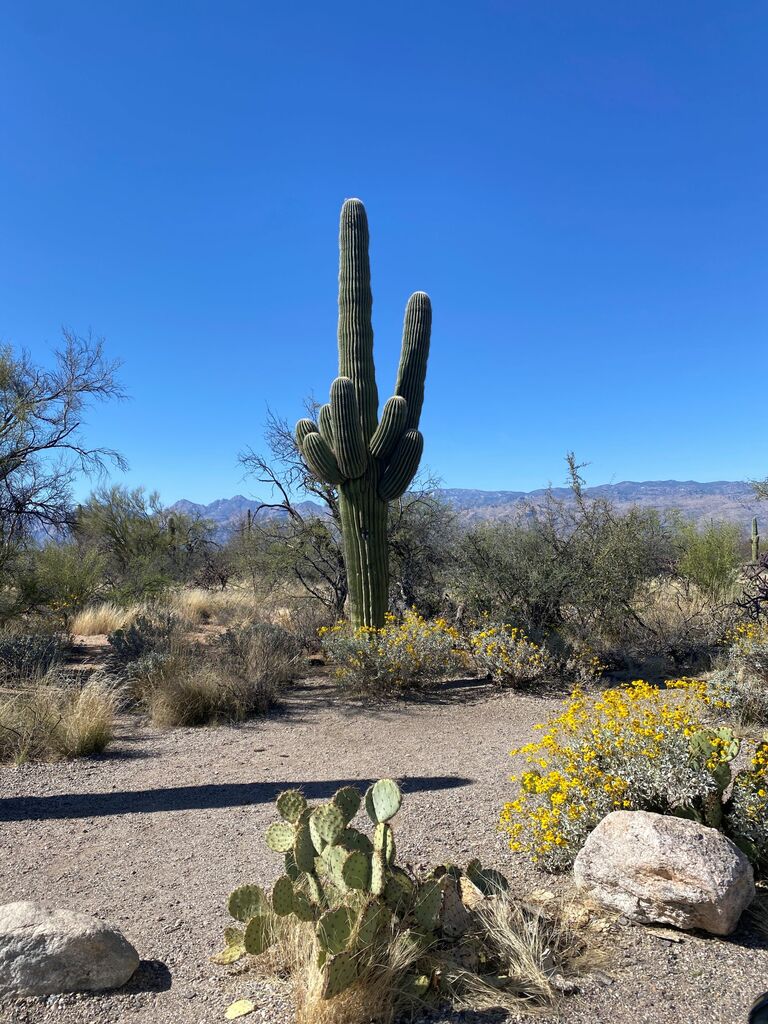Your cart is currently empty!

Captivated by Cacti
If you read last week’s blog, you know we have visited the southwest region of the United States. Lately we have spent a lot of time in Arizona and I’m personally LOVING the red rocks, wildlife, and cacti. While my children are not nearly as enamored with these prickly statuesque wonders, I can say I am absolutely captivated by these desert giants that withstand the arid climate. The deeper question I ask is this: Aren’t we all just like the cacti trying to survive?

There are a few varieties of cacti in the Sonoran Desert area. A couple common cacti we came across are the prickly pear and the saguaro (pronounced sah-wah-roh). The prickly pear cactus produces edible fruit which played a significant role in the desert people’s diets providing not only nutrition but also hydration.
I was curious about what the prickly pear fruit tasted like, so I bought a treat at one of the national park gift stores:

I was pleasantly surprised. I thought the treat tasted like a strawberry lemonade fruit snack. I also found a chocolate bar with prickly pear fruit in it and I found it to be equally delicious.
The saguaro cactus is found throughout the southwestern United States, with a large population preserved at the Saguaro National Park near Tucson, Arizona.
I’m not sure I ever really thought about what a cactus forest looked like, but I discovered they speckle the mountains with their stately figures in every direction, shallow roots sunk in the warm, sandy carpet of the desert. The native people of the Sonoran Desert had a great respect for these cacti. They understood the life and death struggle of these remarkable plants and they parallel to the tribes’ own hard existence. The cacti can grow more than forty-feet tall and live over 150 years, then would die, the plant tissue rotting away, and the desert people would use the ribs of the cacti to build shelters.
We went to a seminar about desert flora and I was enamored with how incredibly vital these plants are to the desert wildlife. For example, a bird in need of a home will peck out a hole in the side of the tough, waxy-coated saguaro cactus. This is where my imagination takes flight. I imagine a cactus mission control where the alarms are blaring and the cactus says, “Red alert! We have a code red intruder! Section off compartment A-1 to secure the structure!” Literally, the cactus cuts off nourishment to the area where the bird invaded the cactus. Fascinating! The area where the bird built its home becomes like an airlock chamber to the cactus and is allowed to dry out and harden, at which point, the bird can build a nest inside the cozy chamber, called a boot. The cactus and the bird can then coexist harmoniously. The cactus is not dying and the bird now has a home.
Another interesting thing about the saguaro cactus is that their age can be estimated based on its height. Once the cactus is approximately seven feet tall (which could be as old as 30-65 years old), they begin to flower annually in the spring, providing food for countless wildlife including bats, birds, bees, and more. After they flower, the plant produces fruit in May and June, which then ripen later in the month. The fruit is then ready to drop its seeds during the rain in July and August.

In addition to providing home and food for desert wildlife, the cactus also has another feature I find fascinating: a shallow root system. Only three to five inches below the ground, their roots and multitude of fine hairs allow the cactus to soak up water quickly in the sizzling southwest heat. This information stopped me in my tracks, it’s genius! The desert region gets less than ten inches of rain annually, so it makes sense that the cactus would need to soak up water quickly before it runs off or evaporates. A large specimen can absorb 200 gallons at a time! Additionally, the saguaro doesn’t even grow its iconic arms until after about thirty-five years. Some of these cacti grow multiple arms, while others produce none, a puzzle botanists still can’t solve.
While I think these are all interesting tidbits, how does this relate to those meaning of life questions I like to delve into in my blogs? Here we go, you know I am not going to leave you with a book report on cacti. As a youngster grows from infancy, they are constantly learning. While it is unknown when we will each hit a growth spurt, there are typically markers where children will start speaking, crawling and walking. Just like the saguaro cactus, no two children are alike. In my own home, for example, our children grow and learn at their own rate. Our oldest seemed to start talking in full sentences around age two while our next few children were delayed in speech. From the ages of birth through age six or so, the children are all developing skills that they will use throughout their life and soaking up everything around them through their own sensory root system. Their environment has a great influence on their life. Just as a cactus adapts to its surroundings for survival, so do people.
As we have traveled the country, we have learned about many people who have overcome hardship and adapted. For example, Abraham Lincoln fascinates me. Having tragically lost his mother at the age of nine, it is understandable how this youngster was devastated. His father remarried and his stepmother was a great influence on the growing boy, encouraging him to read and learn. Lincoln adapted and found a way to survive amidst the tragedy of loss, like a cactus adapts as a bird creates a home in it. The cactus accommodates the bird and both can continue living simultaneously. Don’t underestimate a small, mighty cactus who will continue growing slowly over time. Lincoln did not let the loss of his mother deter him from opening his heart to his new step mother, who loved him like her own and encouraged him throughout his life.
It is unknown how long we will live; each life is different. Some people pass away at a young age while others live to be a hundred or more like the cactus. I believe we are either growing or dying. Another person cannot make you happy, happiness is a choice you make. We can choose whether we thrive like the cactus after a bird has pecked into our spikey outer shell.
It is fascinating that some cacti have many arms and some have none. Some people’s families are tight knit and some are not. Some people escape the most difficult circumstances and some do not. We are all going to experience hardship in life. Something that has always resonated with me in relation to overcoming hardship is learning and constantly growing from experiences. As I shared in this post on my blog a few weeks ago on failing forward, I am still learning, growing, and failing forward with each life experience. I firmly believe that no matter what life circumstances we experience, we are never too old to learn. I came across this quote that I will share with you today from J.K. Rowling:
“It is impossible to live without failing at something, unless you live so cautiously you might as well not have lived at all, in which case you have failed by default.”
How are you like a saguaro cactus? What life experiences have you soaked up with your root system that helped you grow into the person you are today?
Signing off,
-BG Barnstormer
